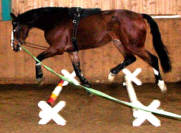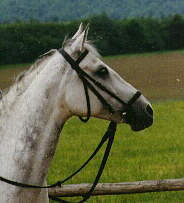
powered by FreeFind
| Main Page | Address |
| A-Z | Forum |
| German Main Page | |
|
Search
Web Search powered by FreeFind |
|
||||||||
 |
reiter.spass.com
Joy and Fun with Horses and Horseback Riding |
 |
The basic workThe basic work is very important for every training level and training hour with your horse.Written by Beate Schulze and translated by Martina Wald |
||
|
||||||||||||||
|
The basic work The basic work is very important for each training level and training hour with your horse. Basic work means that your horse moves
It isn't self-evident and has to be improve and perfected by training exercises again and again.
The rhythm First of all you have to pay attention to
correct rhythm. That doesn't mean only that walk has a four-beat, trot has
a two-beat and canter has a three-beat. For example if you go for
a walk. Your movement is
always constantly, which means your steps always have the same length and
happen in a limited period of time. If you look at this from a small
distance you can count: 1, 2, 3, 4. And now please transfer this to the horse. If you let move your horse without any control sometimes faster and than more slowly it will be nerve-racking, the muscles will cramp and the horse will get tired very quickly. So, you have to pay attention to having always the same ground cover (overstep between hindlegs and forehand) within the same time and in a chronological order according to several paces. Paces are, for example, working trot, collected trot, medium trot and extended trot.
Canter is a movement with even,
impulsive strides giving the impression of an uphill moving canter. Every
stride can be counted in rhythm: 1, 2, 3 1, 2, 3. Every training hour has to begin
working on rhythm, suppleness and submissiveness. These 3 facts are the
fundamental basis for being able to ride movements. The horse should have fun at work, be cooperative and not be an apathetical recipient of its commander. By using spine and leg aids the horse should step through the poll and show a calm head position by chewing the bit as far as possible with closed mouth. The horse has to show a well recognizable, forward stepping movement (without chasing away or getting in a hurry) by stepping forward to the bit and depending on the collection level the hindlegs should move under the centre of gravity more and more. The hindlegs sink because the single joints are being bowed stronger.
Suppleness You only can expect good performance and movements from a relaxed horse. Suppleness includes "to relax", "to let go off" and "to take it easy". Like every human athlete who has to do a limber up training, the horse as an athlete has to warm-up and loose up its muscles. This is important for producing synovia, warming-up, stretching and strengthen the muscles and improving the suppleness. Small or even serious ruptured muscles, sprained tendons and strains can be caused by not warming-up. If the muscular system warms up and begins to relax, a positive tension of body could follow in the working phase. Exercises improving suppleness
Appearance of a relaxed horse
How can I control my horse's suppleness? To allow the reins completely: The horse should stretch forward-downward to the bit and move in rhythm without getting faster or more slowly. Head and poll stretch forward-downward to the yield hand (Picture follows). You have to listen to and look at the individuality of your horse. You should begin with exercises, which easily can be done by your horse. Some horses like to canter after the walk phase immediately and others have a better relaxing by doing leg yielding. Please do not work strictly according to a scheme, it is better to take care for the needs of your horse. Test it out when the best relaxation effect is achieved. And, if the horse prefers another kind of relaxation after some time, do not be afraid of changing the relaxation phase. You do not want to do knee bends first and then sit-ups and finally holding the arms about the head every day. If you do that 300 days a year in the same order again and again, you will be get completely blunt and bored too. If there are any difficulties:
These horses often need a longer relaxing phase or they relax the muscles better by lunging. Solving problems concerning suppleness
|
| Copyright © 2003 / 2007 reiter.spass.com, Forchheim, Germany | Disclaimer of reiter.spass.com | |
|
|
||